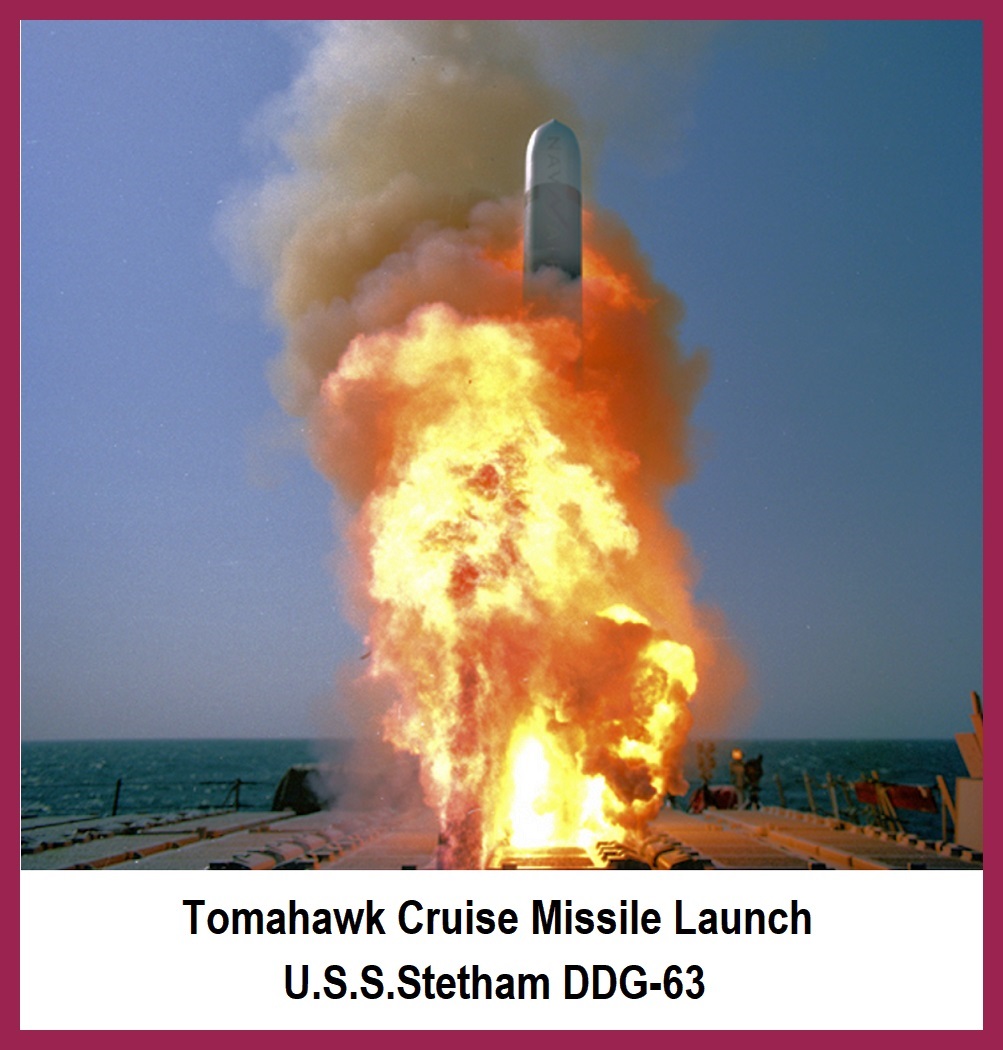
|

|
Tomahawk - The U.S. Navy's Proven Cruise Missile
Tomahawk cruise missiles are designed to fly at extremely low altitudes at high
subsonic speeds, and are piloted over an evasive route by several mission tailored
guidance systems. They were used during multiple, recent U.S. conflicts, and
proved themselves to be overwhelmingly successful as a precision strike
munition.
Over water, the Tomahawk uses inertial guidance or GPS to follow a preset course.
Over land, the missile's guidance system is aided by terrain contour matching
(TERCOM). Terminal guidance is provided by the Digital Scene Matching Area
Correlation (DSMAC) system or GPS, producing a claimed circular error probability
of about 10 meters. The Maritime Tomahawk Block-V will use an active seeker for
terminal guidance.
The current production version of the missile began its initial operational capability
( IOC) in 2004 as the Block IV. At the time, the new Block IV added many new features
as follows:
* ability to reprogram the missile in-flight via two-way satellite communications
* change programming to strike any of 15 pre-programmed alternate targets
* redirect the missile to any Global Positioning System (GPS) target coordinates
* loitering capability over a target area in order to respond to emerging targets
* provide battle damage information to mission commanders with its on-board camera
In 2019, the Block IV missiles started their mid-life, 15 year certification, and the Navy
is using that process to once again update the weapon's capabilities with new
technologies. Recertification requires that every component in the missile be inspected
and tested to assure readiness for combat, so it provides an opportunity to switch out
parts if new features are desired. Tomahawk's modular design facilitates such changes.
Also, upgrades to navigation and communication systems will be completed. A
maritime strike capability has been in development, and this enhancement will be
added concurrently with recertification.
After the recertification and upgrades, all Block IV Tomahawk missiles will become
Block V missiles.
All of the Tomahawks in the fleet will retain their land-attack capability, which enables
precise destruction of high-value targets deep in defended territory with minimal
collateral damage. Whether they are launched from a surface warship or a submarine,
Tomahawk missile are extremely accurate.
Block V differences are as follows:
* Raytheon is adding an anti-ship capability to specific lots of the missile via a new
active homing terminal seeker (Maritime Strike Variant).
* A hard-target kill version will carry a new advanced warhead capable of
penetrating and destroying densely-constructed enemy assets.
General Characteristics: Tomahawk Missile
Type:
* Long-range, all-weather, subsonic cruise missile
Used By:
* United States Navy
* Royal Navy
Manufacturer:
*Raytheon
Mass:
* 2,900 lb. (1,300 kg)
* 3,500 lb. (1,600 kg) with booster
Length:
* Without booster: 18 ft. 3 in. (5.56 m)
* With booster: 20 ft. 6 in. (6.25 m)
Diameter:
* 20.4 in (0.52 m)
Warhead (Conventional):
* 1,000 pounds (450 kg) high explosive or
* submunition dispenser with BLU-97/B Combined Effects Bomb or PBXN
Fuze Mechanism:
* FMU-148
* Others for special applications
Engine:
* Williams International F107-WR-402 turbofan using TH-dimer fuel
* solid-fuel rocket booster
Wingspan:
* 8 ft. 9 in. (2.67 m)
Operational Range:
* Block IV 900 nmi (1,000 mi; 1,700 km)
Flight Altitude:
* 98-164 ft. (30-50 m) above ground level
Maximum Speed
* Subsonic about 550 mph; (480 kn; 890 km/h); ~Mach 0.74
Guidance:
* GPS, INS, TERCOM, DSMAC, active radar terminal homing
Launch Platforms
* Vertical Launch Systems (VLS) of Surface Ships or Submarines
* horizontal submarine torpedo tubes (known as torpedo tube launch or TTL)
Tomahawk Cruise Missile Videos
Videos are embedded and played in the web page. Click on the arrow in the
center of the window to play the video. If a video fails to play embedded,
try playing it on YouTube® by clicking on the Watch on YouTube link in the
lower left corner of the window.
|
|